#bottomland woods
Text
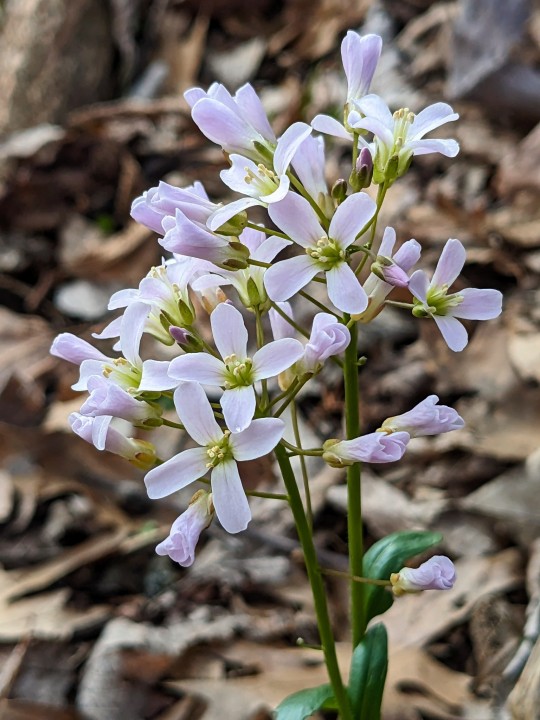

Purple Cress
Cardamine douglassii
Also known as Limestone Cress, this species in the mustard family features clusters of light purple flowers in early spring and can be found in wet and swampy forests with calcium carbonate rich soils. It's native to parts of the eastern United States and southern Ontario, Canada.
The plants I photographed are part of an isolated population remaining in a tiny bottomland forest remnant in St. Charles County, Missouri. Unfortunately, the rest of the forest has been lost due to suburban sprawl and what little of it remains has many invasive species, including winter creeper, callery pear, and japanese honeysuckle trying to encroach from surrounding developments and outcompete native plants like this one.
March 12th & 13th, 2024
St. Charles County, Missouri, USA
Olivia R. Myers
@oliviarosaline
#botany#cardamine douglassii#cardamine#purple cress#bittercress#brassicaceae#nature#naturecore#forest#fairycore#woods#missouri#native plants#native flowers#forests#hiking missouri#suburban sprawl#urban sprawl#ecology#plants#flowers#wildflowers#purple flowers#native plants of america#forest floor#bottomland woods#bottomland forests#nature photography#flower photography#spring
36 notes
·
View notes
Text
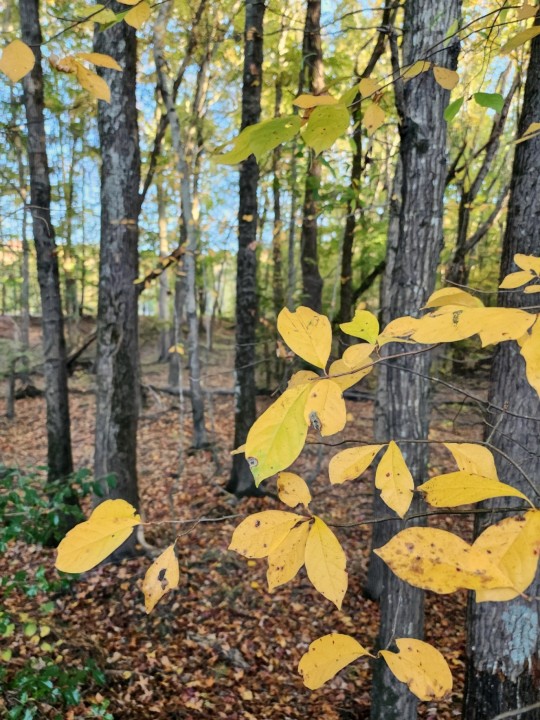
From the Bottomland
Three Lakes Park
Henrico County, Virginia (USA)
Based on a photo from October 28, 2023.
I grew up not far from this bottomland, which was always particularly beautiful in Autumn. The bus I rode to my high school passed right through it, the roadway descending until it reached the lowest elevation above the sprawling wooded stream before rising up again. I still recall mornings where the "bottom" was obscured in dense fog, all of us growing quiet as we listened to our bus driver shifting gears, pulling us through the beautiful and mysterious world of the bottomland.
57 notes
·
View notes
Text
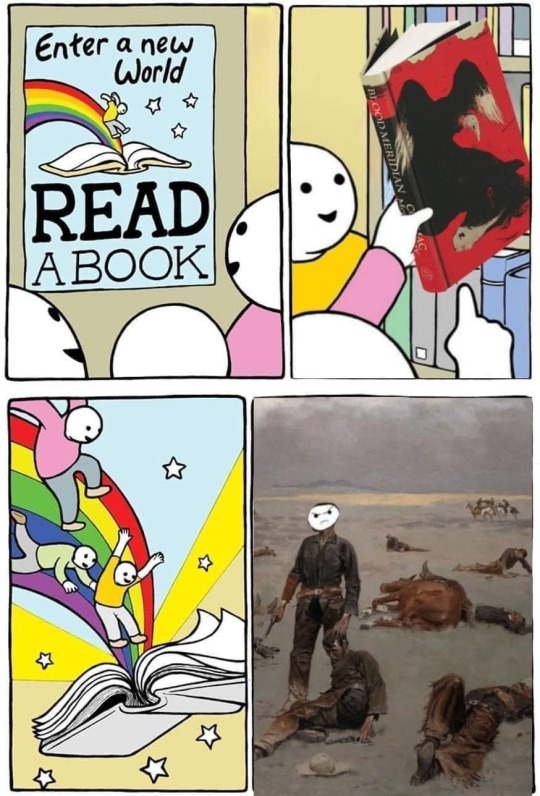
“See the child. He is pale and thin, he wears a thin and ragged linen shirt. He stokes the scullery fire. Outside lie dark turned fields with rags of snow and darker woods beyond that harbor yet a few last wolves. His folk are known for hewers of wood and drawers of water but in truth his father has been a schoolmaster. He lies in drink, he quotes from poets whose names are now lost. The boy crouches by the fire and watches him.
Night of your birth. Thirty-three. The Leonids they were called. God how the stars did fall. I looked for blackness, holes in the heavens. The Dipper stove.
The mother dead these fourteen years did incubate in her own bosom the creature who would carry her off. The father never speaks her name, the child does not know it. He has a sister in this world that he will not see again. He watches, pale and unwashed. He can neither read nor write and in him broods already a taste for mindless violence. All history present in that visage, the child the father of the man.
At fourteen he runs away. He will not see again the freezing kitchenhouse in the predawn dark. The firewood, the washpots. He wanders west as far as Memphis, a solitary migrant upon that flat and pastoral landscape. Blacks in the fields, lank and stooped, their fingers spiderlike among the bolls of cotton. A shadowed agony in the garden. Against the sun's declining figures moving in the slower dusk across a paper skyline. A lone dark husbandman pursuing mule and harow down the rainblown bottomland toward night.
A year later he is in Saint Louis. He is taken on for New Orleans aboard a flatboat. Forty-two days on the river. At night the steamboats hoot and trudge past through the black waters all alight like cities adrift. They break up the float and sell the lumber and he walks in the streets and hears tongues he has not heard before. He lives in a room above a courtyard behind a tavern and he comes down at night like some fairybook beast to fight with the sailors. He is not big but he has big wrists, big hands. His shoulders are set close. The child's face is curiously untouched behind the scars, the eyes oddly innocent. They fight with fists, with feet, with bottles or knives. All races, all breeds. Men whose speech sounds like the grunting of apes. Men from lands so far and queer that standing over them where they lie bleeding in the mud he feels mankind itself vindicated.”
85 notes
·
View notes
Text
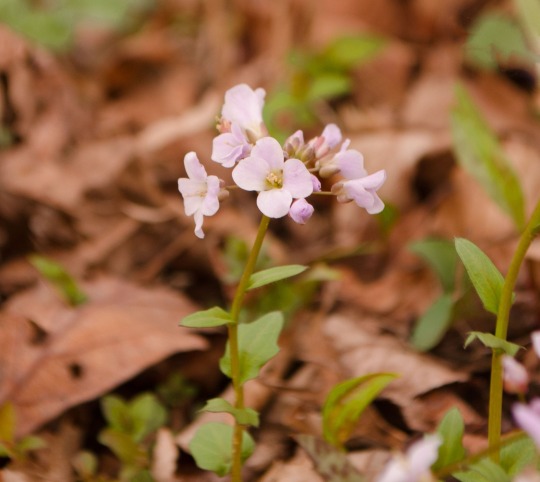
Rich woods, bluffs, mesic bottomland forests, rocky hillsides, floodplains, seepage of bogs, springy areas.
Colors range from purple to a purplish white, it is important to note that entirely white petals are rare among this species. The flowers are borne in a raceme and are typically born in early spring from mid-March to late April. ❤️🌸
#awesome#photography#nature#nature photography#photography is magic#spring photography#spring vibes#woods#flowers#wildflowers
11 notes
·
View notes
Text
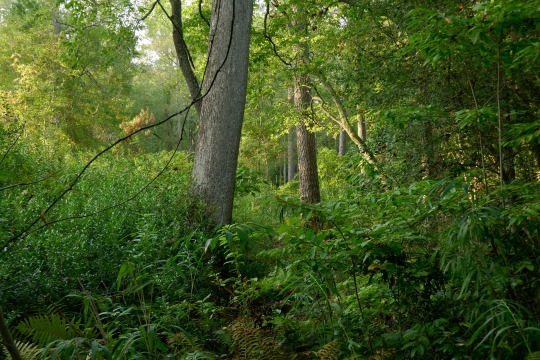
Bottomland Forest, Weymouth Wood Tract
9 notes
·
View notes
Text
updated environment of Western Beleriand part one
Flora, fauna, geography and environment masterlist
Disclaimer: I used both what we can extrapolate is likely indigenous to the region based on descriptions of the landscape and climate as well as my own headcanons and inspirations and reference books on similar habitats as well as books like The Atlas of Middle Earth and The Flora of Middle Earth
Please feel free to ask about any of this, it’d very much a brief overview
Important note: this post is meant to be about the environment in canon with some of my own ideas! That being said Tolkien had obvious bias in his environmental imaginings and I love to explore Beleriand as inspired by other locations! Please feel free to send requests for that!
-Western Beleriand was divided from the East by the River Sirion. It faced the sea to the West.
-Western Beleriand encompasses the coastal regions of Nevrast, the Havens of the Falas and Arvernien. It also includes the landlocked region of Nargothrond, Brethil, parts of Doriath and the woods of Nuath. Some maps and accounts also include Hithlum though this is often considered a region north of Greater Beleriand.
-The River Sirion has two tributaries in western Beleriand, River Narog and River Teglin. Both of these have tributaries of their own.
-Narog was the Southernmost tributary and was one of the largest rivers in Western Beleriand and is the largest of the tributaries to the River Sirion
Ginglith was one tributary to Narog, sourced in wells in the small forest of Núath. It bordered Tumhalad on the West and met Narog some ways North of Nargothrond.
Ringwil, another tributary to Narog was sourced from hills around Nargothrond and ran through the forest Taur-en-Faroth. It was tiny.
-Teglin/Taeglin both met the River Sirion on the borders of Doriath, Teglin flowed from the West through Brethil. Teglin was one of the larger tributaries and had several of its own.
-Celebros meaning ‘silver foam’ was a tributary to Taeglin. It met Taeglin on the western border of Brethil and ran through the forest. At the gorge of Cabed-en-Aras (leap of the deer) near where Celebros met Teglin, Glaurung was slain by Túrin and Niënor took her own life afterwards. The ravine was renamed Cabed Naeramarth or the leap of dreadful doom.
-Maudlin, meaning Golden River, was another tributary to Teglin and ran Northeast to Brethil. Glithui was the third tributary to Teglin and began in the Ered Wethrin from around Amon Darthir. On the other side of this mountain, the source of Nen Lalaith was located.
--One estimate from The Lost Road puts the region at 99 leagues across at its widest but this is not considered Canon and Tolkien often had difficulties in his numerical estimations
My own thoughts!
--Given the descriptions of the region and the different habitats, it is likely a temperate region with temperate coastal parts. That being said, the descriptions are often vague enough that the environment of many different real life places can be explored through it. For example, a Mediterranean climate would fit many of the coastal regions, and Mediterranean forest and scrublands could fit the more inland regions. In real life examples of this can be found throughout coastal Europe, parts of Asia and north Africa, and parts of Australia and New Zealand
-Parts of the river Narog flow underground and have species not found elsewhere in Beleriand outside of the deeper realms of Angband rarely considered by its own inhabitants. On a similar note, Nargothrond is one of the main places outside these deeper parts of Angband (not including marine life) where bioluminescence is found. There are a few bioluminescent species in Menengroth, Nan Tathren, the caves of Nevrast and western Dor-lómin, and Nan Emloth as well.
-West Beleriand consisted of lowlands and bottomlands (the usually flatter floodlands along a watercourse), plains and hilly areas and moorlands. There were also more scattered forested areas and woodlands, as well as the denser Forest of Brethil.
-Resources, imports and goods differ from region to region but overall some of the most prominent resources are timber, clay, wool, orchard fruits, flint, and salt.
-Due to the coastal areas some of the most prominent and advanced shipwrights, cartographers and navigators, and fishers are also found. Many of the coastal communities have studied and mapped the stars as well (I think I have something about this on my post and Barad Nimras)
-The climate was mild though humid without either harsh winters or hotter summers. Colder fronts did occasionally arise from the Encircling Mountains however. The coastal regions, especially around Nevrast, are somewhat warmer and gentler.
-Biodiversity is highest in coastal regions and in the surrounding marshlands.
17 notes
·
View notes
Text
Warbler Showdown; Bracket 1, Poll 6


Townsend's Warbler (Setophaga townsendi)
IUCN Rating: Least Concern
Range: a Western warbler, breeding in British Columbia and southern Alaska and overwintering in the Mexican mountains- though it can sometimes overwinter along coastal California.
Habitat: breeds in tall coniferous and mixed confierous-deciduous forests, most abundantly in unlogged, old-growth forest. Overwinter habitat in California is live oaks and mixed oak-conifer forests, while in Mexico and Central America it includes a variety of montane forest habitats.
Yellow-throated Warbler (Setophaga dominica)
IUCN Rating: Least Concern
Range: The migratory population moves from the Bahamas and Greater Antilles to lowland Eastern and Midwest states; a more sedintary populations seem to live year-round in parts of Florida, Georgia, and Alabama.
Habitat: prefers wetter habitats, such as wooded steam bottomlands and cypress swamps, though they can be found in dry pine or mixed pine-deciduous forests. Also common in loblolly pine stands.
Image Sources: Townsend's (David Turgeon); Yellow-throated (Tyler Ficker)
11 notes
·
View notes
Photo

Broad leaf or Carolina spring Beaut’
Claytonia caroliniana
Virginia spring beaut leaves in background just starting to leaf out
Claytonia virginica
Photographed in RRG in mixed mesophytic woodland, Carolina spring beaut has a few great lakes region United States pops and is mainly found in the core regions of the Appalachian Mountains. A true disjunction as a lower ozark plat pop is in Arkansas; where as the rich alkaline mesic woods and bottomland forests are packed with Virginia spring beaut until you hit semi arid regions and where the central plains starts becoming the rocky mountain region.


26 notes
·
View notes
Text
D.C’s Best Picnic Spots!

Where to go, what to bring
Dining al fresco in D.C. doesn’t have to break the bank. In fact, if you want to avoid making reservations, waiting in line and eating elbow-to-elbow with strangers, planning a picnic is a great alternative. There are so many scenic (Instagram-worthy) spots to throw down a blanket and enjoy this simple and charming tradition. Here we’re sharing some of the best places in D.C. for a picnic – as well as some tips to make your picnic pleasant for all involved.
Hauling your provisions
Although traditional picnic baskets are cute, your best bet is to purchase a modern, sensible picnic backpack since activities in D.C. typically involve walking some distance from your car or taking the metro and hauling a heavy hand-held basket will be cumbersome. Check Amazon for some great options. You can find backpacks with comfortable padded straps and efficiently organized compartments for cutlery, plates, napkins, a cooler, a blanket and more. You might want to invest in two backpacks and share the load with a friend.
Picnic food ideas
Reimagine the ordinary sandwich, chips, and soda. Take it up a notch and serve baguettes; or take it up two notches with quiche, charcuterie boards, fancy salads, and refreshing cocktails. Make sure most of your meal consists of finger foods (easy to eat) so you don’t have to worry about multiple plates/cutlery. And don’t forget dessert!
Another culinary option: order food-to-go from your favorite D.C. restaurant. You’ll still need a method to transport it to your picnic destination, but letting someone else prepare and pack the meal will involve less work on your end.
Don’t forget to pack
Sunscreen
Anti-bacterial wipes
Wet naps
Garbage bags
Bug spray
Places to picnic
We’re providing some tried-and-true venues here, but there are so many more possibilities. Wherever your destination, make sure you learn about parking options (or Metro stops) in advance. Also, do a little research to make sure your spot is picnic friendly and open for visitors.

Between Constitution and Independence Ave., SW
Known as “America’s Front Yard,” this iconic spot is punctuated by the Lincoln Memorial and the Washington Monument and flanked by Smithsonian museums. The long, grassy swath is often crowded, but people-watching can be just as fun as gazing at the patriotic landmarks.

1100 Ohio Drive SW
Located at the southern tip of East Potomac Park between the main branch of the Potomac River and the Washington Channel, Hains Point offers beautiful views of the Potomac River, the Anacostia River and the Washington Channel. It’s an ideal spot for bird watching and also has a playground and restrooms. A four-mile loop allows you to take in the many different species of cherry trees while hiking or biking.

Located on the Potomac River and accessible by George Washington Memorial Parkway
This 90-acre island is a memorial to America’s 26th president and features miles of trails through wooded uplands and swampy bottomlands. Ranger-led programs are available.

16th Street and W Street NW
A spectacular cascading fountain, reflecting pool, statues, and more will be your backdrop at Meridian Hill Park (also known as Malcolm X Park). If you’re there on a Sunday afternoon, you’ll most likely be able to watch a full-blown weekly drum circle party starting at 3 p.m., a tradition that began in the 1960s.
The Yards Park (and Dancing Fountains)
355 Water Street SE
This public space along the Anacostia River has gardens, water features, a dog run, a boardwalk and a shaded overlook.

Wisconsin and K St., NW
This 10-acre park curves along the Potomac River shoreline and includes a large fountain, benches, overlooks and large open lawn areas. A labyrinth with geometric turns encourages quiet contemplation as you wind your way from the outer edge to the center. Stadium-like steps leading to the river edge are a favorite place for picnickers.
Hirshhorn Museum and Sculpture Garden
Independence Ave. SW and 7th St. SW
The sculpture garden is free to enter, offering more than 30 works of contemporary and modern art displayed year-round — and picnics are permitted.
#jamierichards#realtorjamier#realestate#realestateagent#realestatetips#picnic#picnics#picnic spots#dmv#dmv picnic spots#picnic in dmv#how to picnic#where to picnic
2 notes
·
View notes
Text
“Oh the Charity Riverbottoms where the wind that blows this tune like some mouth on a frenchharp is comin from! There in the spring the dogwood used to blossom and blow, and the redbud and yella jessmine; and the katdids ‘ud bleat like the beat of an old rusty heart, and the frogs make such a husky commotion. Oh the sweet breath of the woods — the baby-breath fern and the little woodsviolets and the daylilies; and on Rob’s Hill risin up beyond the old river bridge there’d be Fire on the Mountain blazin like the burnin bushes of Moses. There’s a new steel bridge now and the old one is broken and swaybacked—the one I’d never ride over, was condemned, and would make them let me get out and walk across when we’d go for our rides out on the Highway. (Remember those summer Sundays we had our picnics there and all’d go wadin in the water, and look for good sweetgum and hickry sticks; and some would be fishin with sugarcane poles and others’d be rustlin through the dry palmettas like fieldmice or strollin under the shinin longleaf pines and the blackjack pines — and through it all the sweet little Charity River flowin lazy, and small, and clear as a tear. Instead of all this decoration of the woods, you know what’s there now, oilwells there now, thickern flies, all along there; and all the treefrogs and whipperwills are flown away, caint live in an oil derrick, no nature left, no wonder…) Nothin is like it used to be except the wind blown from the riverbottoms into my shutter to play a tune about what has gone. (The bottomlands are bald and have sluices and slues full of black, muddy oil scabs, can smell it here when the wind’s right. That stink puts all Charity in a spell, they walla in it, it smells money. Never the sweet fresh smell of the old riverbottoms. Is this the vile oil of joy, this green and yellow putrid scum over the ponds?) The world has sold away everthing that was beautiful and as the Lord put it here to be, human beins have changed everything into money and show. Why, out by Tomball the land is littered with oilwell riggins, and day and night the chug-chug-chug and the little flickrin oil flames wavin in the night like the red flags of the Devil staked out to say he owns this infernal land […].”
— William Goyen, The House of Breath (1950)
3 notes
·
View notes
Photo

Scientific Name: Chasmanthium latifolium
Common Name(s): Inland sea oats, inland wood oats
Family: Poaceae (grass)
Life Cycle: Perennial
Leaf Retention: Deciduous
Habit: Graminoid
USDA L48 Native Status: Native
Location: Plano, Texas
Season(s): Fall
When I first heard the name “inland sea oats,” I wondered if it was an oat that grew near an inland sea or if it was some variant of a sea oat that grew inland. Short answer: it’s the latter. Sort of. Then it gets complicated. For starters, there are more names. This plant must’ve hit the jackpot in the common name lottery, because, in addition to inland sea oats and inland wood oats, it’s also called river oats, wood oats (without the “inland”), Indian wood oats, upland oats, wild oats, northern sea oats, plus regional variations, and endless permutations of all these.
This is a shade-tolerant plant native to the southeastern U.S., as shown by the green-tinted areas in the USDA map below. It is found along riverbanks, on floodplains, and in bottomland forests, giving rise to the names “river oats” and “wood oats.”
Its seedheads resemble those of sea oats (Uniola paniculata), which grows on coastal sands. However, since this species is not a coastal plant, the combination of its similar appearance but dissimilar habitat get mashed together into the awkward name “inland sea oats.” As both of these plants were once classified under the same genus (Uniola), it’s not clear to me if they’re as genetically distinct as the separate genera would suggest. So the slightly longer answer to my original question is: it’s a maybe, maybe-not sea oat that grows inland.
However, neither plant has ever been associated with Avena, which is the genus to which our breakfast oats belong. I thnk using the name “wild oats” on this plant is just going to cause confusion, because the farmed oat (Avena sativa) has a wild relative (Avena fatua), and its common name is — wait for it — wild oat.
It should be clear by now that common names can be unreliable, but perhaps the most nonsensical one here is “northern sea oats,” because this species is not native to the north, not a seaside plant, and not an oat. How anyone came up with that name is a complete mystery to me.

#Chasmanthium latifolium#inland sea oats#inland wood oats#Poaceae#perennial#deciduous#graminoid#native#Plano#Texas#fall#autumn#fruit#brown#tan#plantblr
6 notes
·
View notes
Text
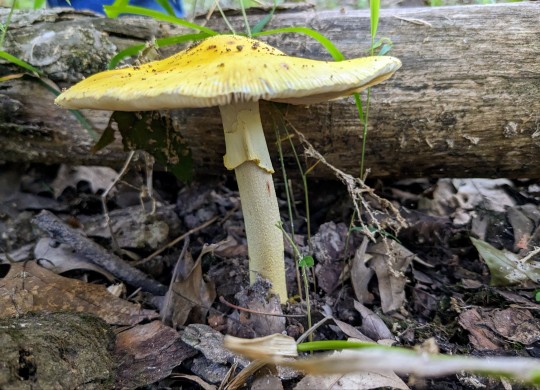


Amanita section Validae
I found this gorgeous, lemon yellow amanita mushroom in a healthy bottomland forest surrounded by pin oaks, river birches, and American elms.
July 26th, 2023
Arnold, Jefferson County, Missouri, USA
Olivia R. Myers
@oliviarosaline
#mycology#Amanita Sect. Validae#amanita mushrooms#amanita#nature#woods#naturecore#forest floor#fairycore#missouri#cottagecore#ozarks#the ozarks#forest#mushrooms#fungi#wild fungi#wild mushrooms#bottomland woods#naturalist#mushroomcore#yellow mushrooms#mushroom photography#nature photography#fungi photography#exploring the woods#mushroom#toadstool
45 notes
·
View notes
Text

Jewels in the Woods
Henrico County, Virginia (USA)
Photo from September 11, 2021.
Jewelweed is native to North America, often seen along creeks, streams, and in bottomlands.
31 notes
·
View notes
Text
Living Like Weasels by Annie Dillard
A weasel is wild.
Who knows what he thinks?
He sleeps in his underground den, his tail draped over his nose.
Sometimes he lives in his den for two days without leaving.
Outside, he stalks rabbits, mice, muskrats, and birds, killing more bodies than he can eat warm, and often dragging the carcasses home.
Obedient to instinct, he bites his prey at the neck, either splitting the jugular vein at the throat or crunching the brain at the base of the skull, and he does not let go.
One naturalist refused to kill a weasel who was socketed into his hand deeply as a rattlesnake.
The man could in no way pry the tiny weasel off, and he had to walk half a mile to water, the weasel dangling from his palm, and soak him off like a stubborn label.
And once, says Ernest Thompson Seton--once, a man shot an eagle out of the sky.
He examined the eagle and found the dry skull of a weasel fixed by the jaws to his throat.
The supposition is that the eagle had pounced on the weasel and the weasel swiveled and bit as instinct taught him, tooth to neck, and nearly won.
I would like to have seen that eagle from the air a few weeks or months before he was shot: was the whole weasel still attached to his feathered throat, a fur pendant?
Or did the eagle eat what he could reach, gutting the living weasel with his talons before his breast, bending his beak, cleaning the beautiful airborne bones?
I have been reading about weasels because I saw one last week.
I startled a weasel who startled me, and we exchanged a long glance.
Twenty minutes from my house, through the woods by the quarry and across the highway, is Hollins Pond, a remarkable piece of shallowness, where I like to go at sunset and sit on a tree trunk.
Hollins Pond is also called Murray's Pond; it covers two acres of bottomland near Tinker Creek with six inches of water and six thousand lily pads. In winter, brown-and-white steers stand in the middle of it, merely dampening their hooves; from the distant shore they look like miracle itself, complete with miracle's nonchalance.
Now, in summer, the steers are gone. The water lilies have blossomed and spread to a green horizontal plane that is terra firma to plodding blackbirds, and tremulous ceiling to black leeches, crayfish, and carp.
This is, mind you, suburbia. It is a five-minute walk in three directions to rows of houses, though none is visible here.
There's a 55-mph highway at one end of the pond, and a nesting pair of wood ducks at the other. Under every bush is a muskrat hole or a beer can.
The far end is an alternating series of fields and woods, fields and woods, threaded everywhere with motorcycle tracks--in whose bare clay wild turtles lay eggs.
So, I had crossed the highway, stepped over two low barbed-wire fences, and traced the motorcycle path in all gratitude through the wild rose and poison ivy of the pond's shoreline up into high grassy fields.
Then I cut down through the woods to the mossy fallen tree where I sit. This tree is excellent. It makes a dry, upholstered bench at the upper, marshy end of the pond, a plush jetty raised from the thorny shore between a shallow blue body of water and a deep blue body of sky.
The sun had just set. I was relaxed on the tree trunk, ensconced in the lap of lichen, watching the lily pads at my feet tremble and part dreamily over the thrusting path of a carp.
A yellow bird appeared to my right and flew behind me. It caught my eye; I swiveled around—and the next instant, inexplicably, I was looking down at a weasel, who was looking up at me.
Weasel! I'd never seen one wild before.
He was ten inches long, thin as a curve, a muscled ribbon, brown as fruitwood, soft-furred, alert. His face was fierce, small and pointed as a lizard's; he would have made a good arrowhead.
There was just a dot of chin, maybe two brown hairs' worth, and then the pure white fur began that spread down his underside.
He had two black eyes I didn't see, any more than you see a window.
The weasel was stunned into stillness as he was emerging from beneath an enormous shaggy wild rose bush four feet away.
I was stunned into stillness twisted backward on the tree trunk.
Our eyes locked, and someone threw away the key.
Our look was as if two lovers, or deadly enemies, met unexpectedly on an overgrown path when each had been thinking of something else: a clearing blow to the gut.
It was also a bright blow to the brain, or a sudden beating of brains, with all the charge and intimate grate of rubbed balloons. It emptied our lungs.
It felled the forest, moved the fields, and drained the pond; the world dismantled and tumbled into that black hole of eyes. If you and I looked at each other that way, our skulls would split and drop to our shoulders.
But we don't. We keep our skulls. So.
He disappeared.
This was only last week, and already I don't remember what shattered the enchantment.
I think I blinked, I think I retrieved my brain from the weasel's brain, and tried to memorize what I was seeing, and the weasel felt the yank of separation, the careening splash-down into real life and the urgent current of instinct.
He vanished under the wild rose. I waited motionless, my mind suddenly full of data and my spirit with pleadings, but he didn't return.
Please do not tell me about "approach-avoidance conflicts." I tell you I've been in that weasel's brain for sixty seconds, and he was in mine.
Brains are private places, muttering through unique and secret tapes-but the weasel and I both plugged into another tape simultaneously, for a sweet and shocking time.
Can I help it if it was a blank?
What goes on in his brain the rest of the time? What does a weasel think about?
He won't say. His journal is tracks in clay, a spray of feathers, mouse blood and bone: uncollected, unconnected, loose leaf, and blown.
I would like to learn, or remember, how to live. I come to Hollins Pond not so much to learn how to live as, frankly, to forget about it.
That is, I don't think I can learn from a wild animal how to live in particular--shall I suck warm blood, hold my tail high, walk with my footprints precisely over the prints of my hands?--but I might learn something of mindlessness, something of the purity of living in the physical sense and the dignity of living without bias or motive.
The weasel lives in necessity and we live in choice, hating necessity and dying at the last ignobly in its talons. I would like to live as I should, as the weasel lives as he should.
QAnd I suspect that for me the way is like the weasel's: open to time and death painlessly, noticing everything, remembering nothing, choosing the given with a fierce and pointed will.
I missed my chance. I should have gone for the throat. I should have lunged for that streak of white under the weasel's chin and held on, held on through mud and into the wild rose, held on for a dearer life.
We could live under the wild rose wild as weasels, mute and uncomprehending. I could very calmly go wild. I could live two days in the den, curled, leaning on mouse fur, sniffing bird bones, blinking, licking, breathing musk, my hair tangled in the roots of grasses.
Down is a good place to go, where the mind is single. Down is out, out of your ever-loving mind and back to your careless senses. I remember muteness as a prolonged and giddy fast, where every moment is a feast of utterance received.
Time and events are merely poured, unremarked, and ingested directly, like blood pulsed into my gut through a jugular vein.
Could two live that way? Could two live under the wild rose, and explore by the pond, so that the smooth mind of each is as everywhere present to the other, and as received and as unchallenged, as falling snow?
We could, you know.
We can live any way we want.
People take vows of poverty, chastity, and obedience--even of silence--by choice. The thing is to stalk your calling in a certain skilled and supple way, to locate the most tender and live spot and plug into that pulse.
This is yielding, not fighting.
A weasel doesn't "attack" anything; a weasel lives as he's meant to, yielding at every moment to the perfect freedom of single necessity.
I think it would be well, and proper, and obedient, and pure, to grasp your one necessity and not let it go, to dangle from it limp wherever it takes you.
Then even death, where you're going no matter how you live, cannot you part. Seize it and let it seize you up aloft even, till your eyes burn out and drop; let your musky flesh fall off in shreds, and let your very bones unhinge and scatter, loosened over fields, over fields and woods, lightly, thoughtless, from any height at all, from as high as eagles.
We could, you know. We can live any way we want.
People take vows of poverty, chastity, and obedience--even of silence--by choice.
The thing is to stalk your calling in a certain skilled and supple way, to locate the most tender and live spot and plug into that pulse.
This is yielding, not fighting.
A weasel doesn't "attack" anything; a weasel lives as he's meant to, yielding at every moment to the perfect freedom of single necessity.
I think it would be well, and proper, and obedient, and pure, to grasp your one necessity and not let it go, to dangle from it limp wherever it takes you.
Then even death, where you're going no matter how you live, cannot you part.
Seize it and let it seize you up aloft even, till your eyes burn out and drop; let your musky flesh fall off in shreds, and let your very bones unhinge and scatter, loosened over fields, over fields and woods, lightly, thoughtless, from any height at all, from as high as eagles.
#annie dillard#living like weasels#philosophy#psychology#story#writing#great writers#desire#purpose#ambition#weasel#luke burgis#mimetic theory#mimesis#rene girard
4 notes
·
View notes
Text
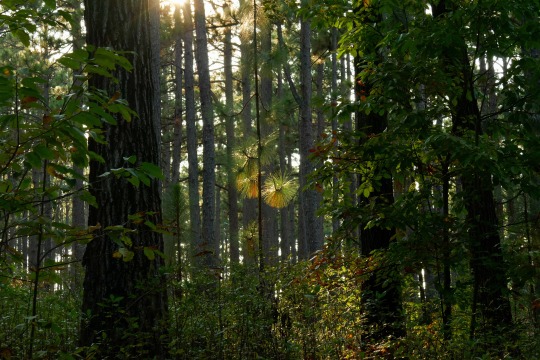


A Few Steps Along Lighter Stump Trail, Weymouth Woods
At times the forest seems like a house—light and airy rooms above, ceilings high enough to accommodate the height of pines singing in the wind, but then take the stairs down to the basement, light retreats into shadow and the walls lean-in, down there a cellar full of hardwoods and vines talking about bottomland life as they sip on sedate waters.
6 notes
·
View notes
Text
Retro-Life Journal
Retro Camouflage's Return to Popularity?
It came to my attention several years ago, while browsing in a sporting goods store, a camouflage pattern I hadn't seen since my youth. As I looked at the design hanging on the rack, a flood of nostalgia came over me. That pattern was MossyOak Bottomlands.
Military Start
In order to see where we are with the revival of retro camouflage, we must take a look at its history. The first military use of a breakup style camo was in WWII with M1942 used by the Marine Corps.

M1942 Camouflage Pattern. Also referred to as Frog Skin.
After WWII, soldiers returning home either used black and red buffalo plaid for hunting, or made use of the surpluses of the M1942 pattern by incorporating it into their hunting and sporting needs. It would become known as "Duck Hunter" and "Brown Camo" by its users. The popularity of the pattern, especially among duck and bird hunters, saw that it would be copied and used up until the early 90s by some companies.
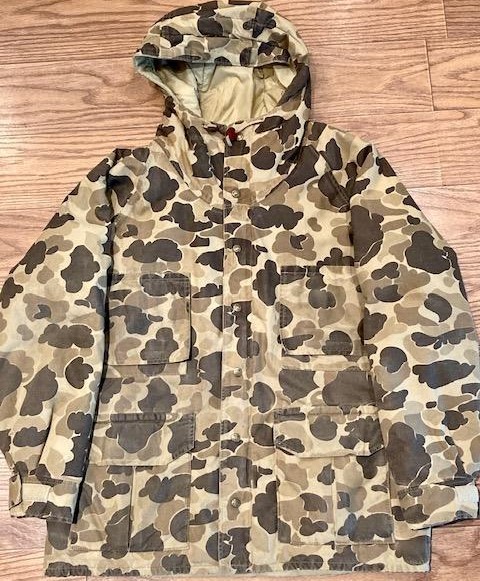
My vintage Columbia Gortex Hunting Jacket in "Duck Hunter" pattern. This was put out by Columbia from the late 1970s-early 1990s.
Like with M1942 the surplus market would give, and still gives, hunters a way to break up their outlines. Tiger Stripe, ERDL, and M81 woodland are patterns tried and used by many. Even up into the 90s, it wasn't uncommon around rural Northwest Georgia, where I live, to see M81 surplus being used in the deer woods.
Rise of the Commercial Market
The first attempt at making a commercial camouflage pattern, not based on military design, was TreBark. In the early 1970s, Jim Crumley a bow hunter from Virginia decided that the surplus patterns available thru mail-order and surplus stores weren't enough. By using a gray color base, and odorless brown and black markers, the first commercial pattern TreBark was born. It would take off for success in 1983 when Cabela's offered it in the fall catalog.

The Original TreBark pattern.
In 1986, two other big names would enter the arena. MossyOak and RealTree. Like with Ford vs. Chevrolet, or Remington vs. Winchester, MossyOak and RealTree would start a debate on which pattern is better for years to come. Both Companies would evolve from the original patterns, and offer several different styles to fit the environment the hunter would be in. As manufacturing and technology advances, a lot of these patterns are 3D and in HD these days.
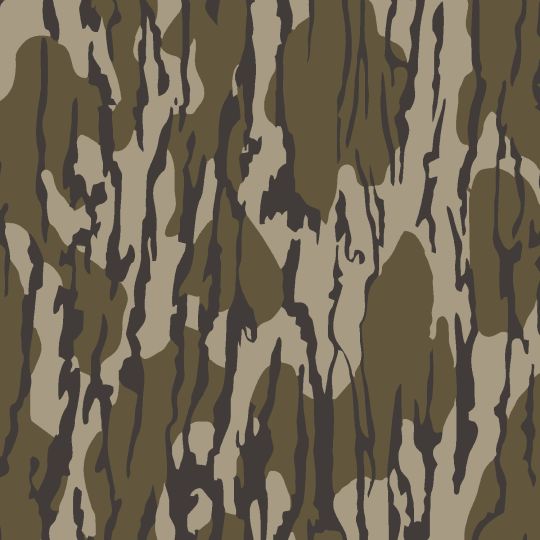
Original MossyOak Bottom Lands.*I like to believe that some inspiration came from M1942 in the base design.*
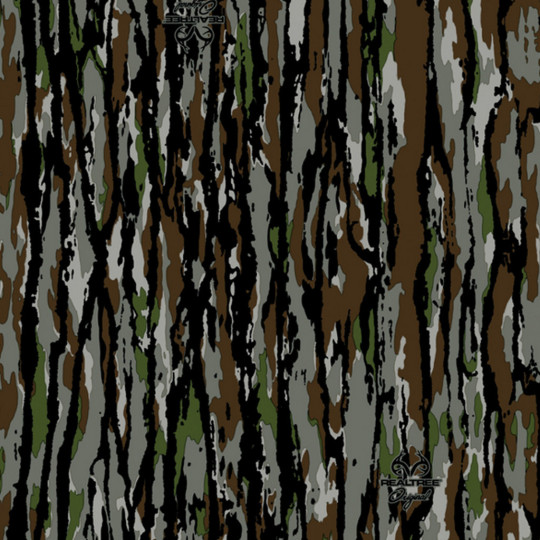
Original RealTree.*I like to believe that TreBark inspired this design*
Current Times and Revival of Retro Patterns.
With all the advances in camouflage these days, it's exciting for a retro lover such as myself to see a revival of the old-school patterns. With MossyOak bringing back bottomlands, Drake offering what they are calling Old School; to folks customizing their boats, guns, and even tactical equipment in retro patterns, it's a welcome bit of nostalgia in today's shooting and sporting world. The trend toward using old-school camouflage for personalization and simpler practicality, over more recent offerings, I believe is part of the revival. It's easier to customize guns and equipment for example in the older and more basic patterns, when using paint, Cerakote, or coatings such as Alumahyde. Another part is just the cool factor and nostalgia it brings. There are several smaller companies offering retro type camouflage accessories, giving folks an option to style their guns or gear that way. JunkyardOps and Flatline Fiber Co. shown below are two of many examples of these type companies, and you can find a lot of options to do custom coatings in whatever pattern you want from Brownells. Either way, whatever pattern you decide on, be it old military or commercial camouflage, I believe it's a welcome sight in today's time!
Some examples of retro camouflage patterns giving some personality and customization:
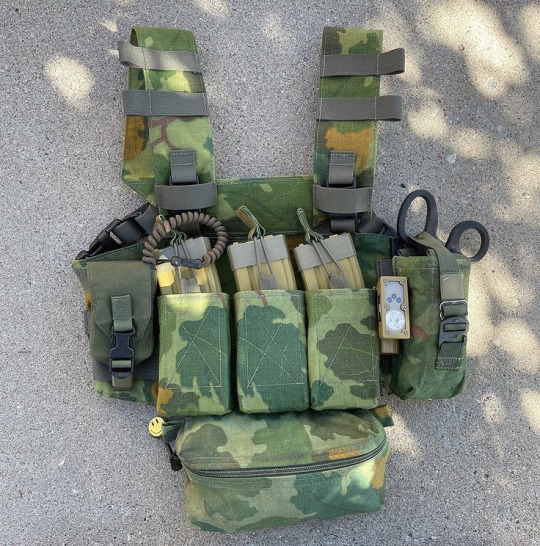
Modern Custom Chest Rig made from M1942 shelter half. (Photo courtesy of owner @carbinesandcoffee on Instagram)
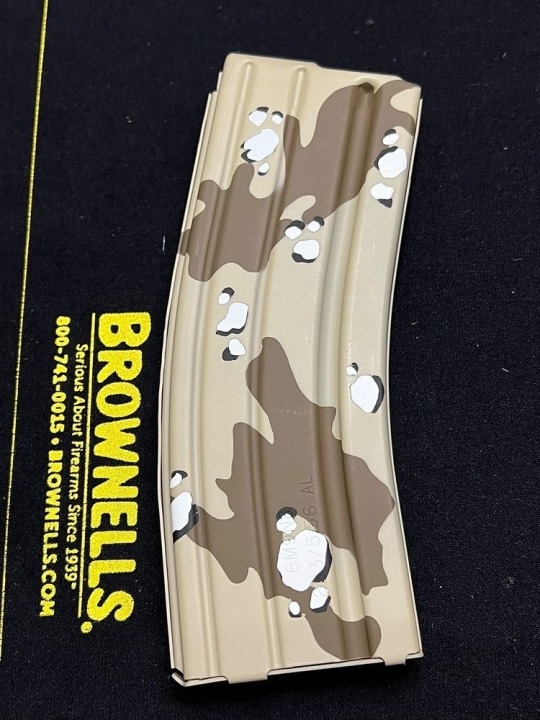
Cerakoted Retro “chocolate chip” desert camo magazine for an AR15, available from JunkyardOps.(photo courtesy of @its.miller.time on Instagram)

A Brownells BRN180(a modern retro design rifle in itself) featuring a retro pattern Tiger Stripe sling made by Flatline Fiber Co. (photo courtesy of owner @thee_adam_jagger on Instagram)
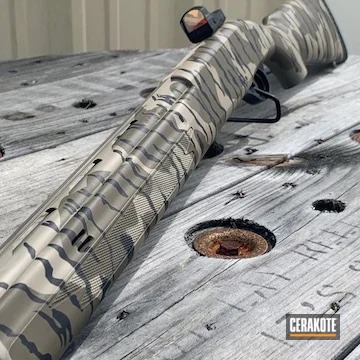
Weatherby Shotgun that has been Cerakoted in MossyOak Classic Bottomlands. (Photo sourced from Cerakote’s website)

My own Personal HK VP9, Custom camouflaged in a duckhunter pattern camouflage using Brownells Alumahyde II. It’s an affordable and durable way for a person to customize guns and gear with an aerosol epoxy paint type coating.
*You can Find all the different Alumahyde II colors in the link below, if you want to try your own hand at customizing your Guns and Gear. But be warned it is addictive once you start. You’ll be wanting to customize everything!*
#bureauofpropaganda#retrolifejournal#camouflage#retro#retro life#brownells#2a#hunting#firearms#equipment#gear
5 notes
·
View notes